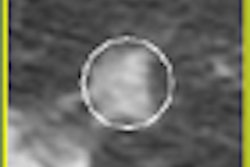
VIENNA - Agreement between diameter-based and semiautomated nodule volume measurements is poor and often overestimates nodule size from a volumetric perspective, according to results from a Dutch study presented at ECR 2015.
Among nodules chosen randomly from a large lung cancer screening trial, volumes extrapolated from mean diameters led to overestimation of nodule size by nearly 50% -- and the differences were far greater for a subset of irregularly shaped nodules, said Dr. Marjolein Heuvelmans from University Medical Center Groningen.
"Agreement between diameter-based and semiautomatically derived volume is poor, and applying diameter measurements in CT lung cancer screening leads to substantial shifts in nodule stratification compared to volume measurements," Heuvelmans said in her talk.
Many lung cancer screening guidelines, such as those from the American College of Chest Physicians (ACCP), are based on nodule diameter measurements, she said. In some of these guidelines, diameter-based volume is needed to calculate nodule growth doubling times, and the diameter-based volumes are calculated assuming the nodule to be a perfect sphere. This assumption strays far from the highly irregular reality of pulmonary nodules, though the actual agreement between nodule volume and nodule diameter is unknown.
 Dr. Marjolein Heuvelmans from University Medical Center Groningen.
Dr. Marjolein Heuvelmans from University Medical Center Groningen."Therefore the purpose of this study was to determine the agreement between semiautomated volume and diameter measurements of indeterminate lung nodules found in low-dose CT lung cancer screening," Heuvelmans said.
The 2,240 nodule samples came from 1,498 participants in the Nederlands-Leuvens Longkanker Screenings Onderzoek (NELSON) screening trial, who were current or former heavy smokers ages 50 to 75 years with at least one solid pulmonary nodule at baseline screening. Every studied nodule had a volume between 50 mm3 and 500 mm3.
"After radiologists selected a lung nodule by mouse click, nodule volume and diameter were automatically calculated by LungCare software" (Siemens Healthcare), Heuvelmans said. Nodules were further classified as smooth, lobulated, spiculated, or irregular. Diameter was defined as maximum diameter in the axial plane, and a formula was applied to calculate diameter-based volume.
In the study, for 100 randomly selected nodules, diameters were measured manually by two radiologists working independently, and the measurements were compared with the semiautomated volume-deducted diameters. Finally, the researchers evaluated nodule reclassification based on a diameter-based protocol.
A Bland-Altman plot showed an overestimation of 85% for nodule volume based on maximum transversal diameter for all nodules. For a subset of spiculated nodules, the overestimation was 134%; for irregular nodules, the overestimation was more than 160%, Heuvelmans said.
Another analysis involved the rate of reclassification for indeterminate lung nodules from 4 mm to 8 mm and 4 mm to 10 mm based on ACCP and National Lung Screening Trial (NLST) criteria, respectively.
Among the 4- to 10-mm nodules, reclassification agreement between the two measurement methods was 92.1%, meaning that 177 (7.9%) nodules were reclassified upward to a positive test result.
"Direct referral [for workup] instead of short-term follow-up CT would have occurred in almost 8% of the nodules," she said.
Among the 4- to 8-mm nodules, reclassification agreement was 77.9%, with 495 (22.1%) nodules reclassified upward.
"Based on the diameter criteria, no nodules were reclassified downward to a negative test result," Heuvelmans said.
The use of semiautomatic volume calculations for the diameter-based volumes was a limitation of the study, she noted. Also, because the LungCare software uses the optimal diameters in the x-y plane based on 3D evaluation, the discrepancy between diameters and x-y nodule volume is likely even higher than the study results demonstrate.
Agreement between diameter and semiautomatically derived volumes is poor and leads to substantial differences in stratification in CT lung cancer screening, Heuvelmans concluded.
Audience member Bram van Ginneken, PhD, professor of functional image analysis at Radboud University Medical Group in Nijmegen, the Netherlands, questioned the study methodology, noting that both the Lung-RADS and Fleischner guidelines recommend taking either the mean or the maximum of the longest and shortest diameters for calculations, or using the average diameter, thus rendering the differences between the measurement methods based on maximum transversal diameter much smaller.
Heuvelmans said the researchers also applied those methods to their data, but it did not reduce the overestimation.
"For the mean diameter, the overestimation for the overall group was over 40%," she said. "For spiculated and irregular nodules, the overestimation was over 100%."
"Still, those are very different numbers -- I'm simply saying that dynamic measurements lead to a substantial shift, and it really depends on how you do the diameter," van Ginneken said.



















